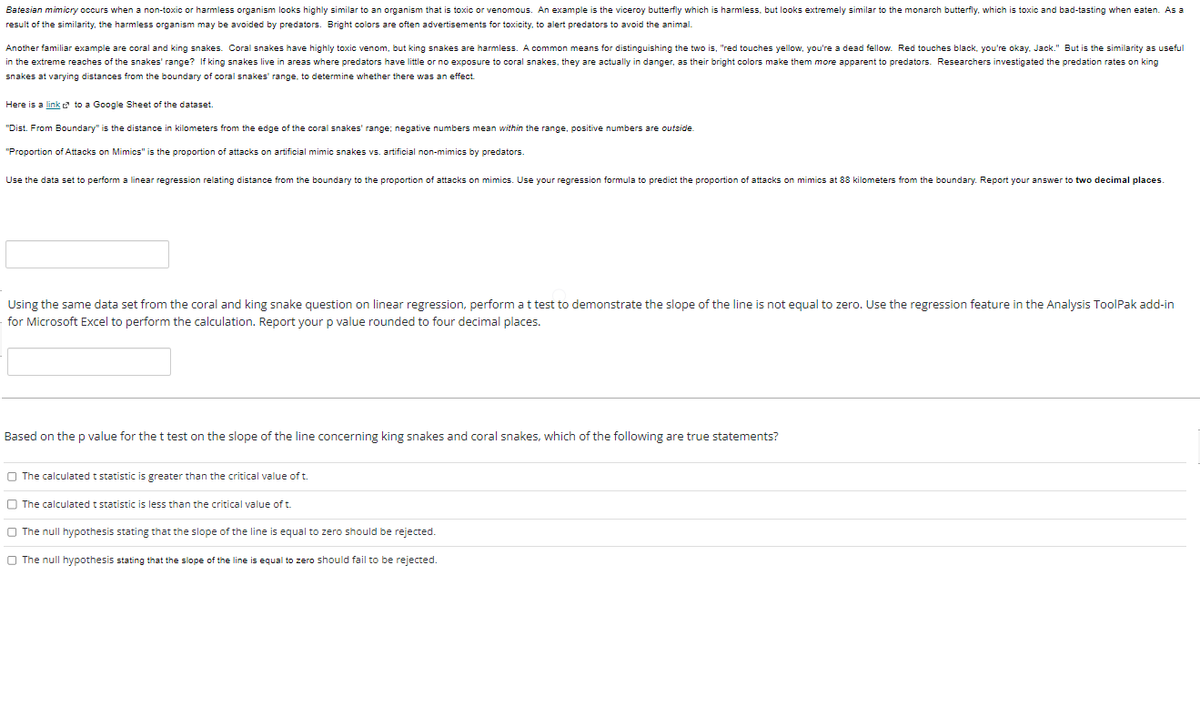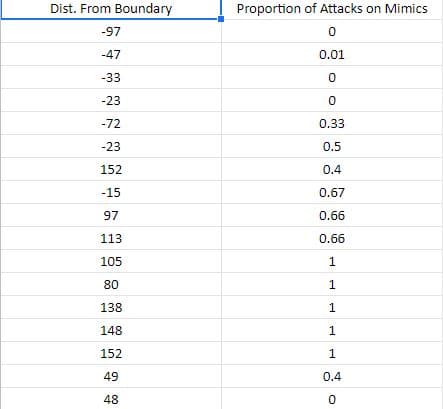a Google Sheet of the dataset. dary" is the distance in kilometers from the edge of the co cks on Mimics" is the proportion of attacks on artificial mi perform a linear regression relating distance from the b
a Google Sheet of the dataset. dary" is the distance in kilometers from the edge of the co cks on Mimics" is the proportion of attacks on artificial mi perform a linear regression relating distance from the b
Algebra & Trigonometry with Analytic Geometry
13th Edition
ISBN:9781133382119
Author:Swokowski
Publisher:Swokowski
Chapter9: Systems Of Equations And Inequalities
Section9.3: Systems Of Inequalities
Problem 15E
Related questions
Question

Transcribed Image Text:Batesian mimicry occurs when a non-toxic or harmless organism looks highly similar to an organism that is toxic or venomous. An example is the viceroy butterfly which is harmless, but looks extremely similar to the monarch butterfly, which is toxic and bad-tasting when eaten. As a
result of the similarity, the harmless organism may be avoided by predators. Bright colors are often advertisements for toxicity, to alert predators to avoid the animal.
Another familiar example are coral and king snakes. Coral snakes have highly toxic venom, but king snakes are harmless. A common means for distinguishing the two is, "red touches yellow, you're a dead fellow. Red touches black, you're okay. Jack." But is the similarity as useful
in the extreme reaches of the snakes' range? If king snakes live in areas where predators have little or no exposure to coral snakes, they are actually in danger, as their bright colors make them more apparent to predators. Researchers investigated the predation rates on king
snakes at varying distances from the boundary of coral snakes' range, to determine whether there was an effect.
Here is a link to a Google Sheet of the dataset.
"Dist. From Boundary" is the distance kilometers from the edge of the coral snakes' range; negative numbers mean within the range, positive numbers are outside.
"Proportion of Attacks on Mimics" is the proportion of attacks on artificial mimic snakes vs. artificial non-mimics by predators.
Use the data set to perform a linear regression relating distance from the boundary to the proportion of attacks on mimics. Use your regression formula to predict the proportion of attacks on mimics at 88 kilometers from the boundary. Report your answer to two decimal places.
Using the same data set from the coral and king snake question on linear regression, perform a t test to demonstrate the slope of the line is not equal to zero. Use the regression feature in the Analysis ToolPak add-in
for Microsoft Excel to perform the calculation. Report your p value rounded to four decimal places.
Based on the p value for the t test on the slope of the line concerning king snakes and coral snakes, which of the following are true statements?
The calculated t statistic is greater than the critical value of t.
The calculated t statistic is less than the critical value of t
The null hypothesis stating that the slope of the line is equal to zero should be rejected.
The null hypothesis stating that the slope of the line is equal to zero should fail to be rejected.

Transcribed Image Text:Dist. From Boundary
-97
-47
-33
-23
-72
-23
152
-15
97
113
105
80
138
148
152
49
48
Proportion of Attacks on Mimics
0
0.01
0
0
0.33
0.5
0.4
0.67
0.66
0.66
1
1
1
1
1
0.4
0
Expert Solution
This question has been solved!
Explore an expertly crafted, step-by-step solution for a thorough understanding of key concepts.
This is a popular solution!
Trending now
This is a popular solution!
Step by step
Solved in 2 steps with 1 images

Recommended textbooks for you

Algebra & Trigonometry with Analytic Geometry
Algebra
ISBN:
9781133382119
Author:
Swokowski
Publisher:
Cengage

Elementary Geometry for College Students
Geometry
ISBN:
9781285195698
Author:
Daniel C. Alexander, Geralyn M. Koeberlein
Publisher:
Cengage Learning

Algebra & Trigonometry with Analytic Geometry
Algebra
ISBN:
9781133382119
Author:
Swokowski
Publisher:
Cengage

Elementary Geometry for College Students
Geometry
ISBN:
9781285195698
Author:
Daniel C. Alexander, Geralyn M. Koeberlein
Publisher:
Cengage Learning